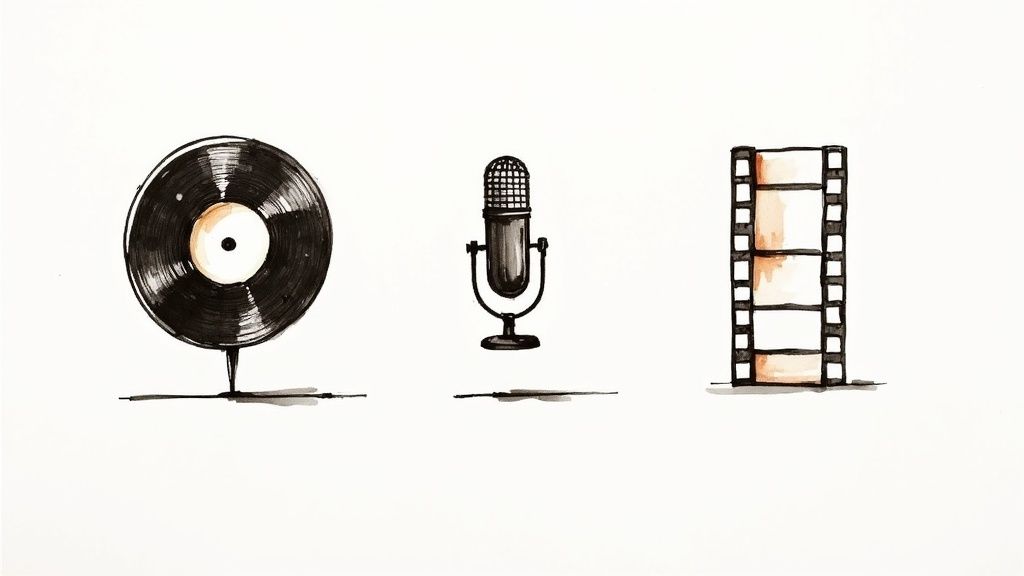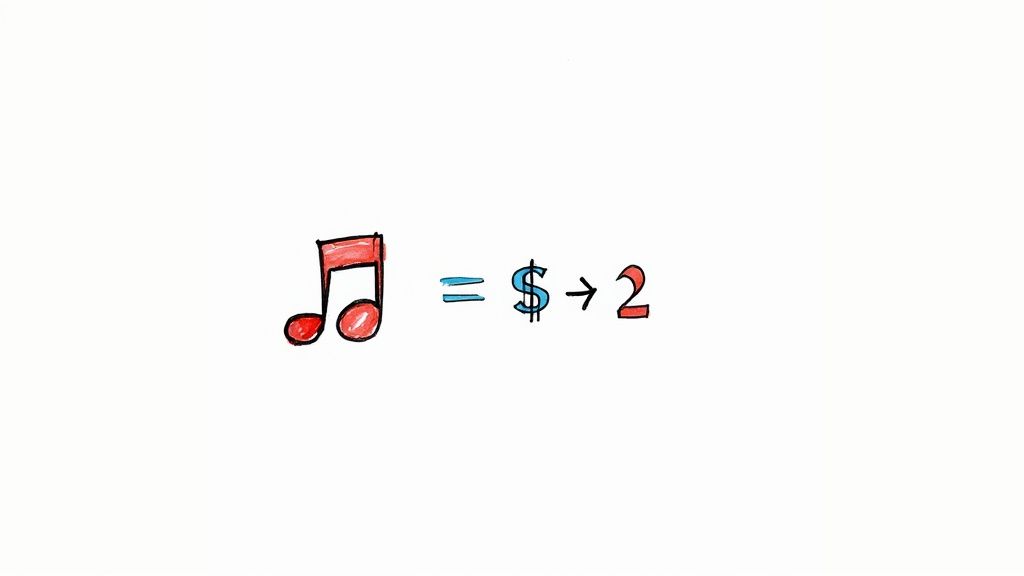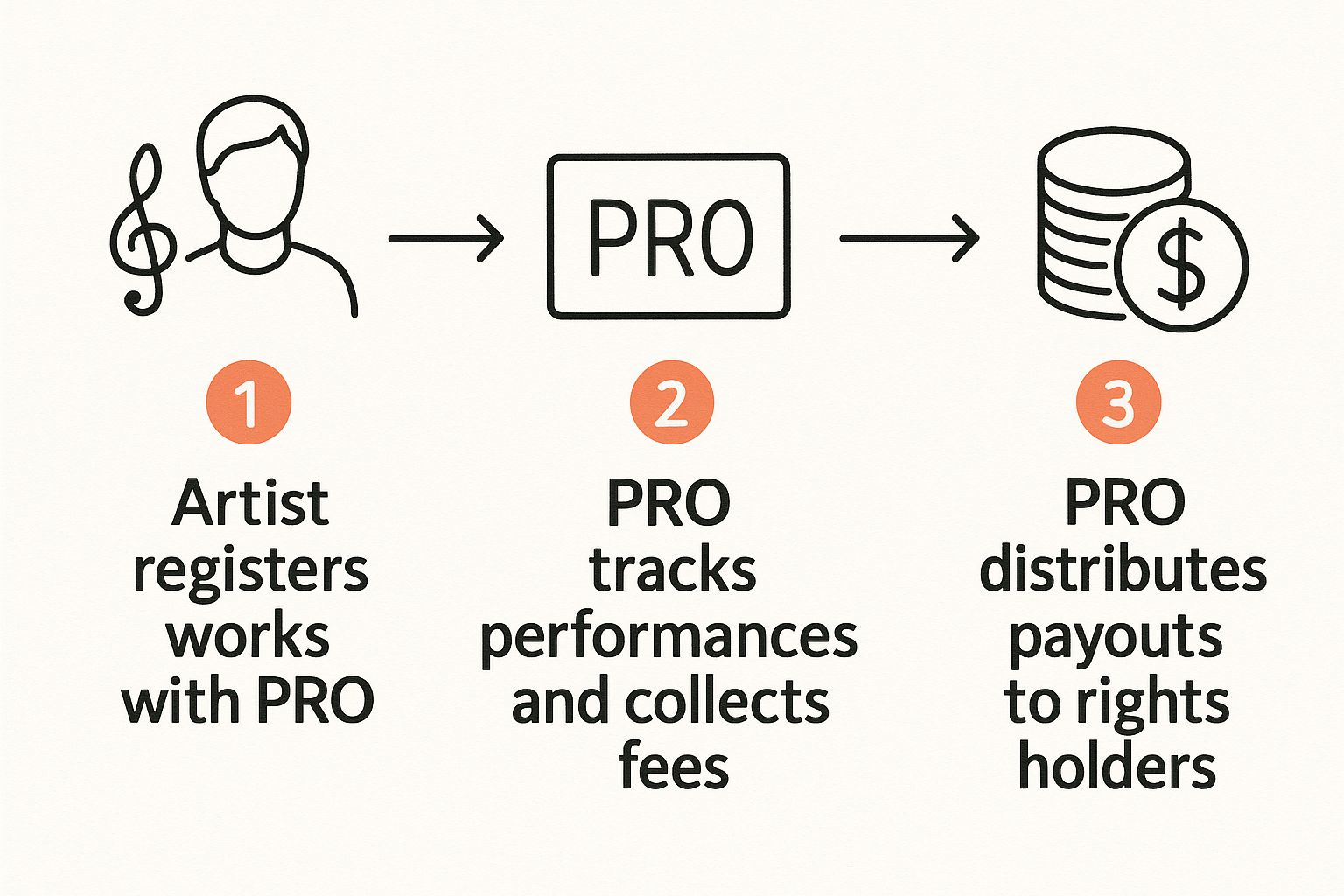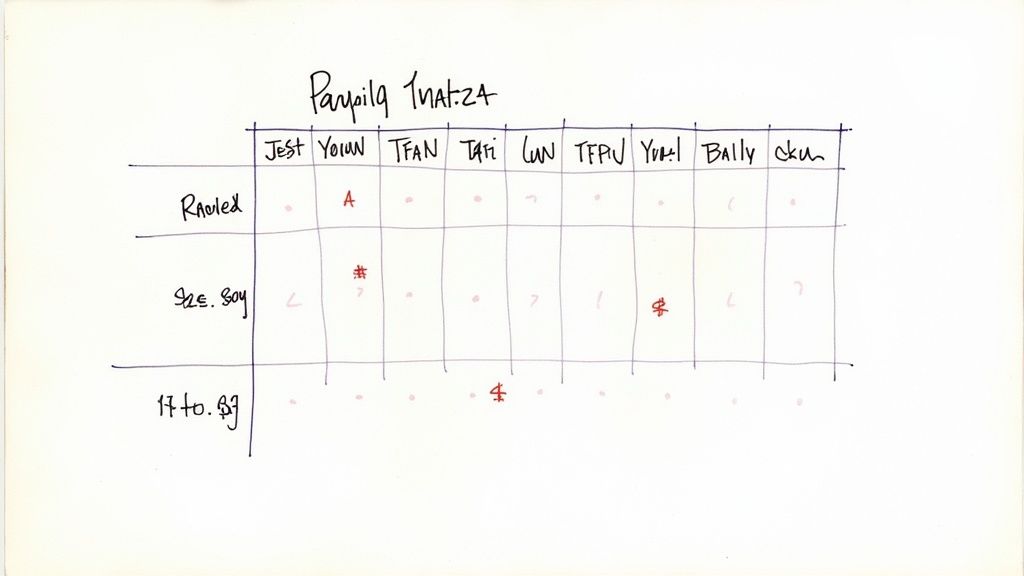How Do Music Royalties Work? A Complete Artist's Guide
- Schach Brett
- Jul 28
- 14 min read
So, what exactly are music royalties?
Think of it this way: you own a piece of property—your song. Music royalties are the rent you get paid every single time someone uses that property. It doesn't matter if it's a stream on Spotify, a spin on the radio, or a feature in a new Netflix show. You own it, you get paid for its use.
This system is the financial engine of the entire music industry. For any artist trying to build a real career, understanding how it works isn't just a good idea; it's absolutely essential.
How Do Music Royalties Actually Work?
At its core, the concept is simple. A tiny payment is generated for the rights holders every time a song is played, reproduced, or performed in public. The money flows from the listener or user, through a collection system, and eventually back to the creator.
The real challenge? Tracking the billions of individual plays happening all over the world. That's where the royalty system steps in. It's a complex but logical network built to make sure those countless micro-payments find their way home.
For an even more detailed breakdown of this whole process, you can check out our complete insider guide to music royalties.
Who Collects the Money?
You don’t have to go knocking on every radio station's door to get paid. Thankfully, a whole network of organizations handles the heavy lifting for you. These groups are set up specifically to track where your music is used, collect the fees, and get the money into your pocket.
Here are the main players you need to know:
Performance Rights Organizations (PROs): These are the big names like ASCAP, BMI, and SESAC. They track public performances—think radio, TV, bars, venues, and even certain types of streams. They collect license fees from these businesses and pay the songwriters and publishers.
The Mechanical Licensing Collective (The MLC): A crucial player in the modern streaming world. In the U.S., The MLC is responsible for collecting and paying out mechanical royalties from digital streaming services to songwriters and publishers. This covers the "reproduction" of your song every time it's streamed.
SoundExchange: This organization is all about the master recording. SoundExchange collects and distributes digital performance royalties for plays on non-interactive digital radio services like Pandora, SiriusXM, or iHeartRadio. The key difference is they pay the recording artists and the label (master owners), not the songwriters.
To get a better handle on these different royalty streams, let's quickly summarize where they come from.
Quick Look at Key Music Royalty Types
Royalty Type | What It Pays For | Generated By |
|---|---|---|
Mechanical | The reproduction of a song (physical or digital) | Music streams, CD/vinyl sales, digital downloads |
Performance | The public performance or broadcast of a song | Radio/TV airplay, streams, live venues, restaurants |
Sync | Placing a song in visual media | Movies, TV shows, commercials, video games |
Each of these represents a different income stream you could be tapping into.
Simply put, royalties are the lifeblood of a musician's income. Without a clear system for collection and distribution, artists wouldn't get compensated for the value their work brings to businesses and audiences worldwide.
Navigating this ecosystem is the first step toward making sure you're collecting every cent you've earned. As we go deeper, we'll unpack exactly what these different royalty types are and how they apply to you.
Understanding a Song's Two Copyrights

Before we can even talk about how music royalties work, we need to get one fundamental thing straight. Every single song you've ever heard actually has two separate legal identities. Think of them as two distinct pieces of intellectual property, and each one generates its own unique streams of cash.
Getting these two mixed up is easily one of the biggest and most common mistakes I see artists make. So let's clear it up right now.
I find the easiest way to think about it is like building a house. First, before any work can begin, an architect has to draw up the blueprint. This blueprint is the core idea—the layout, the structure, the very soul of the house. In the music world, this is the composition copyright.
The Composition Copyright (The Blueprint)
The composition is the song in its most basic form. It's the melody you can't get out of your head and the lyrics you sing in the shower. It's the essential DNA of the track.
This copyright belongs to the people who created it: the songwriter(s) and, if they have one, their music publisher.
Just like a single blueprint can be used to build a whole neighborhood of identical houses, one composition can be recorded and performed by dozens of different artists. Every new cover, every remix, every new version is still built from that original blueprint.
The Sound Recording Copyright (The House)
Now, once you have the blueprint, a construction crew comes in and builds the actual house. This finished building is the physical thing you can see and touch. In music, this is the sound recording copyright, which you'll often hear called the "master."
The sound recording is a specific, finished version of that composition. It’s the actual MP3 file you stream on Spotify, the grooves on a vinyl record, or the file on a CD.
This copyright belongs to the recording artist who performed it and the record label that likely paid for the studio time and production.
Key Takeaway: A songwriter owns the song itself (the composition), while a recording artist owns a specific version of that song (the sound recording). These two copyrights pay different royalties to different people.
This distinction is the bedrock of the entire music royalty system. It's the reason a songwriter like Dolly Parton still earns money when Whitney Houston's iconic version of "I Will Always Love You" gets played. Both of their teams get paid because both copyrights are being used.
The explosion of streaming has made understanding both copyrights more critical than ever. When you see a number like Spotify paying out $10 billion in a single year, that money is being split between the owners of the compositions and the owners of the sound recordings.
This growth is also fueling a more global and diverse industry. For instance, artists are now earning over $100,000 in royalties from music recorded in more than 50 different languages, which shows how these two copyrights power a worldwide music economy. You can dig deeper into these numbers in Spotify’s 2025 "Loud & Clear" report.
The Four Main Royalty Streams Explained

Alright, so we’ve established that every song is actually two things: the composition (the song itself) and the sound recording (the specific version you hear). Now it's time to follow the money.
Each time your music gets used, it generates a specific type of royalty tied to one of those copyrights. Getting a handle on these different income streams is absolutely essential to understanding how you get paid in the real world.
Think of it like this: there are four main pipelines, and each one carries money from a different type of music use. Some pipelines flow to the songwriter, some to the recording artist, and some to both. Let's break down each one.
1. Mechanical Royalties
This one sounds old-school, and that's because it is. The name is a direct holdover from when music was literally pressed onto player piano rolls. Today, a mechanical royalty is generated any time your song is reproduced—physically or digitally. It's a payment for making a copy of the composition.
These royalties are paid out to songwriters and their publishers. In today's music world, you'll see them triggered most often by:
Interactive Streaming: Every single time someone actively clicks to play your song on Spotify or Apple Music, that counts as a reproduction.
Digital Downloads: When a fan buys your track on a platform like iTunes or Amazon Music, a copy is made.
Physical Sales: Pressing your music onto vinyl, CDs, or even cassettes triggers mechanical royalties.
So, if an indie label presses 500 vinyl copies of your latest single, they owe mechanical royalties to the songwriters for every single one of those 500 records.
2. Performance Royalties
This is one of the most common ways artists and songwriters make a living. Performance royalties are generated whenever a song is performed or broadcast in public. And "public" means a lot more than just a live concert.
These royalties are paid to songwriters and publishers. A public performance can be any of these:
Radio Airplay: Getting your song on AM/FM radio or a satellite station like SiriusXM.
Streaming Services: Both on-demand platforms (Spotify) and non-interactive internet radio (Pandora) count as public performances.
Live Venues: When your band—or even a cover band—plays your song at a bar, club, or concert hall.
Businesses: Music playing in the background at restaurants, gyms, coffee shops, and stores.
Important Note: For digital radio streams (like on Pandora), a separate performance royalty is also generated for the sound recording. This money is collected by a specific organization called SoundExchange and paid directly to the recording artist and the record label.
3. Synchronization (Sync) Royalties
You'll often hear this one called "sync" for short. A sync royalty is earned when your music is paired with any kind of visual media. This is where the big paydays can happen, though landing a sync deal can be one of the toughest gets in the business.
Why? Because it requires licensing both the composition and the sound recording.
Sync royalties are usually paid as a one-time upfront "sync fee," which is negotiated case-by-case. The money is split between all rights holders: songwriters, publishers, recording artists, and labels.
Common sync placements include:
Movies and movie trailers
TV shows and commercials
Video games
Online ads and corporate videos
Imagine a director wants to use your track in a key scene for a new HBO show. The production company has to cut a deal to license both the "blueprint" (your composition) and the "house" (your recording) to make it happen.
4. Streaming Royalties (A Modern Hybrid)
Streaming is where things get a little tricky because it isn't just one royalty type. It's a hybrid.
A single stream on a platform like Spotify actually triggers both mechanical and performance royalties at the same time. This is the main reason why royalty collection feels so complex today. For every single stream, money is owed to both the composition owners and the sound recording owners, and it all has to flow through different collection agencies before it finally gets to the creators.
How Royalties Are Collected and Paid Out
Earning royalties is one thing, but getting paid is another. How does the money from a stream in Sweden or a radio spin in Ohio actually find its way into your bank account? The journey from a listener's ear to an artist's pocket is a winding one, managed by a global network of collection agencies that act as the music industry's financial plumbing.
You don’t just walk up to Spotify and ask for your cash. Instead, specialized organizations are responsible for tracking every play, collecting the fees, and getting that money to the right people. Think of them like toll collectors on the music superhighway, making sure everyone who owns a piece of the road gets their cut.
This system is essential. It's estimated that a staggering $1 billion in royalties fails to reach its rightful owners every single year. Knowing who these players are and what they do is the first step to claiming your share and making sure you’re not part of that statistic.
The Key Collection Agencies
Two of the most important groups you'll encounter are Performance Rights Organizations (PROs) and Mechanical Rights Organizations (MROs). You’ll need to work with both.
Performance Rights Organizations (PROs): These are groups like ASCAP, BMI, and SESAC. They’re in charge of collecting performance royalties. They issue licenses to radio stations, TV networks, bars, and streaming services, then pay the money out to songwriters and publishers.
Mechanical Licensing Collective (The MLC): In the United States, The MLC is a huge deal. It was created specifically to collect and distribute mechanical royalties from digital streaming platforms. They’re the ones who make sure songwriters and publishers get paid when their songs are streamed on services like Spotify.
This infographic breaks down how the money flows through a PRO.

As you can see, it's a pretty straightforward loop: you register your songs, the PRO tracks when and where they're played, collects the fees, and then pays you. It’s a similar setup for The MLC with mechanicals and with an organization called SoundExchange, which handles digital performance royalties for recording artists and labels.
Following the Money in a Growing Market
The global music market is blowing up, which makes these collection agencies more critical than ever. Global recorded music revenues recently hit $29.6 billion, with streaming making up over $20 billion of that total. This incredible growth means there’s more money on the table, but it also means you have to be diligent about getting your music properly registered to claim your piece of it. You can read the full IFPI report for a deeper dive into these trends.
The bottom line is simple: you have to register your songs with the correct organizations. If you don't tell them what you own, they can't pay you when your music gets used. Forgetting this step is like working a job but never signing up for direct deposit.
This process applies to everyone who owns a piece of a song. For every single stream, multiple royalty payments are triggered. The PROs and The MLC collect the money for the composition side (for songwriters and publishers), while distributors and SoundExchange handle the money for the master recording side (for artists and labels). Getting your head around these payout structures is a non-negotiable skill for any serious artist, and you can learn more about how to calculate Spotify royalties accurately in our detailed guide.
Calculating Your Earnings from Streaming

Alright, this is the part every artist really wants to know: how do you turn those streams into actual dollars? Calculating streaming royalties can feel like a black box because there isn't a single, fixed rate for every stream. Instead, most big platforms use what's called a “pro-rata” system.
It’s just a fancy way of saying they pool all their revenue and then divide it up.
Imagine all the money a platform like Spotify makes from subscriptions and ads in one month is one giant pizza. Your "slice" of that pizza is based on your share of the total streams that happened that same month. If your music accounted for 0.01% of all streams, you get 0.01% of the money from that pizza. Simple as that.
This also means the per-stream payout rate literally changes every single month. It all depends on how much revenue was generated and how many total streams occurred across the entire platform.
Why Per-Stream Payouts Vary
So, the exact amount you earn per stream is never a clean number. It's not as simple as "one stream equals X cents" because the value of each individual stream is different.
Several key factors are at play here:
The Listener's Location: A stream from someone in a country with high subscription costs, like the U.S. or Switzerland, will usually pay more than one from a country with lower-priced plans.
The Listener's Subscription Plan: It makes sense that a stream from a Premium subscriber is worth more than a stream from someone on a free, ad-supported plan.
Your Distribution Deal: The percentage your distributor or label takes is a huge factor. That cut comes out before the money ever hits your bank account.
This is exactly why fixating on a single "per-stream" number can be super misleading. But we can use industry averages to get a realistic picture of the streaming economy. For a deeper dive into these numbers, our guide on how to build real music income with a Spotify royalties calculator breaks it down even further.
A Realistic Look at Streaming Payouts
Let's get down to it: how many streams does it actually take to make meaningful money? The numbers can be a bit of a reality check, but they’re crucial for setting realistic goals. Payouts from different streaming services can vary wildly.
For example, Spotify’s average payout hovers around $0.00437 per stream. To earn $1,000, you’d need about 229,000 streams. Over on Apple Music, the rate is generally higher, so you might only need somewhere between 128,000 and 179,000 streams to hit that same $1,000 mark.
Key Insight: Don't put all your eggs in one basket. Relying on a single streaming service for income is tough. A diversified strategy that includes multiple platforms, sync licensing, and performance royalties will almost always serve you better.
To put this all into perspective, let's compare what it takes to earn $1,000 on a few of the major platforms. The table below shows just how much the numbers can differ.
Streaming Payout Comparison (Estimated)
Streaming Platform | Average Payout Per Stream | Streams Needed for $1,000 |
|---|---|---|
Spotify | ~$0.00437 | ~229,000 |
Apple Music | ~$0.0078 | ~128,000 |
SoundCloud | ~$0.00325 | ~307,000 |
Keep in mind, these are just estimates and they're always changing. But they do a great job of illustrating the sheer volume of streams you need to generate significant income from streaming alone.
Common Questions About Music Royalties
Even after you get a handle on the different types of royalties, the practical side of things can still feel a bit fuzzy. The music royalty world is full of little details and nuances, and honestly, that’s where artists either get paid what they're owed or unknowingly leave a pile of cash on the table.
Think of this last section as a way to tie up loose ends. We're going to tackle some of the most common—and often confusing—questions we hear from artists all the time. Let’s clear these up so you have a complete picture of how music royalties work in the real world.
How Long Does It Take to Receive Royalties?
One of the toughest pills to swallow for new artists is the long wait between your music getting played and the money actually hitting your bank account. As a general rule, you should brace yourself for a delay of anywhere from three to nine months. Sometimes, it’s even longer.
So, why the hold-up? It's because the money has to travel through a multi-step pipeline. First, a platform like Spotify or a local radio station has to log every single play. Then, they package up all that usage data and send it over to the right collection society, like ASCAP or The MLC. From there, the society has to sift through mountains of data, figure out who gets what, and finally send out the payments.
A song streamed in January might not show up in your bank account until a collection society's second or third quarterly payout, which could land in June or even September. It’s absolutely vital to factor this lag time into your financial planning.
Do I Need a Publisher to Collect All My Royalties?
Okay, so technically, do you need a publisher? No. But trying to collect every single cent you're owed without one is a monumental, if not impossible, task. For any serious artist, a publisher or a publishing administrator (think Songtrust or CD Baby Pro Publishing) is an essential partner for maximizing what you earn.
Here’s a breakdown of why they're so critical:
Performance Royalties: As a songwriter, you can sign up directly with a PRO like BMI or ASCAP to get your "writer's share" of performance royalties. Easy enough. But the other half—the "publisher's share"—will just sit there, uncollected, unless you have a publishing entity to claim it.
Mechanical Royalties: This is where it gets really tricky. Trying to collect mechanical royalties on your own, especially from overseas, is a nightmare for an independent artist. Publishers have the global connections and infrastructure to register your songs in dozens of countries and chase down these complex royalties for you.
Bottom line: Partnering with a publishing administrator is a non-negotiable step if you want to make sure you’re not leaving your own money behind.
Can I Earn Royalties from Playing My Own Songs Live?
Yes! And this is hands-down one of the most overlooked income streams for artists who tour or play live shows. Anytime you perform your original music at a registered venue—whether it's a bar, club, or festival—it counts as a public performance.
Those venues pay annual license fees to PROs for the right to play music in their space. As a member of a PRO, you can log into your account and submit your setlists from every single gig. Your PRO will then pay you the writer's share of performance royalties generated by your own show. It takes a little admin work on your end, but it's literally money you've already earned. Don't miss out.
What Is the Difference Between a PRO and SoundExchange?
This is a huge point of confusion, and it trips up a ton of artists. They both handle performance royalties, but they collect for completely different copyrights and from different kinds of music use.
Here’s a simple way to think about it:
Organization | Collects For | Pays | For What Kind of Use? |
|---|---|---|---|
PROs (ASCAP, BMI) | The Composition (The Song) | Songwriters & Publishers | All public performances (radio, streaming, live venues) |
SoundExchange | The Sound Recording (The Master) | Recording Artists & Labels | Non-interactive digital streams (Pandora, SiriusXM) |
So, if your song gets played on a Pandora radio station, your PRO pays the songwriter and publisher, while [SoundExchange](https://www.soundexchange.com/) pays the recording artist (that’s you!) and the record label. It is absolutely crucial to register with both a PRO (for your songwriting) and SoundExchange (for your performance on the recording) to get all the money you're owed.
Ready to take control of your music career? artist.tools offers a powerful suite of data tools to help you grow on Spotify, from bot detection and playlist analysis to royalty calculators and AI-powered pitch generators. Stop guessing and start making data-driven decisions at https://artist.tools.